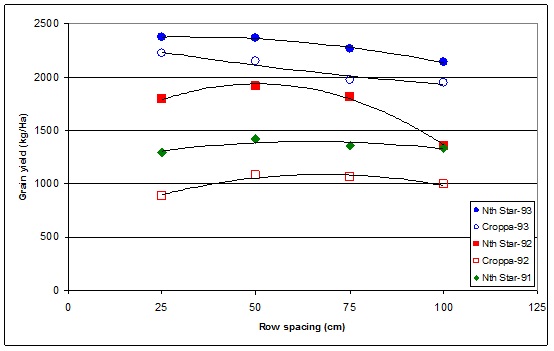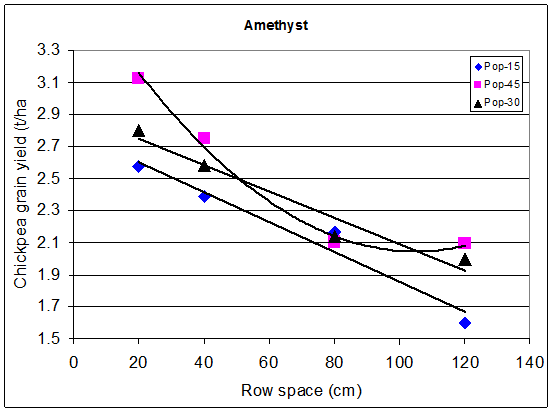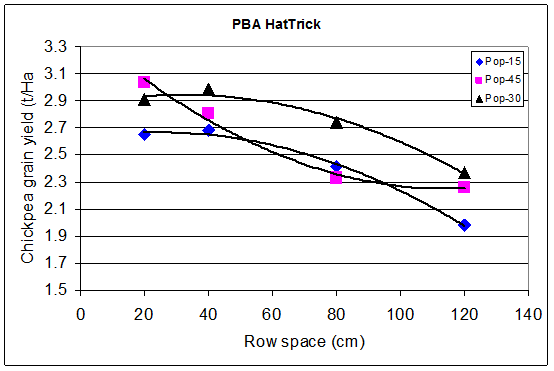Effect of row spacing on yield in chickpea under high yield potential
Author: Andrew Verrell and Leigh Jenkins | Date: 05 Mar 2014
Past and present research
GRDC code: DAN00171
 Varieties displaying this symbol beside them are protected under the Plant Breeders Rights Act 1994.
Varieties displaying this symbol beside them are protected under the Plant Breeders Rights Act 1994.
Authors
Andrew Verrell, Tamworth Agricultural Institute, NSW Department of Primary Industries, Tamworth NSW 2340, Australia. andrew.verrell@dpi.nsw.gov.au
Leigh Jenkins, Trangie Agricultural Research Institute, NSW Department of Primary Industries, Trangie NSW 2823, Australia. leigh.jenkins@dpi.nsw.gov.au
Take home message
- When sowing within the optimum sowing window mid May – mid June;
- yield potential ≥ 2.0 t/ha sow on narrow rows (≤ 40cm)
- yield potential ≤ 2.0 t/ha row spacing has less of an impact on yield
- When sowing very late, sow on narrow rows at high plant density
- When sowing very early, sow on wider rows to reduce early soil water extraction
- Current varieties (PBA HatTrick
 ) have a lower rate of yield decline at wider row spacing
) have a lower rate of yield decline at wider row spacing
Introduction
Chickpeas are successfully grown using a wide range of row spacing’s, ranging from 20-100 cm with wider rows (50-100cm) becoming quite common. In northern New South Wales and Queensland, the current rule of thumb is that row spacing ranging from 25-75 cm results in no yield difference (Cumming and Jenkins, 2011).
These guidelines were based on the original research work of Felton et al (1996) conducted in the early 90’s. There was a need to look at the effect of row spacing under high yield potential situations utilising current varieties and newer agronomic practices.
Pioneering row spacing research
Research in the 1990’s demonstrated that no-till increased chickpea yields by 10%. Wider row spacing was seen as a means of increasing the commercial attractiveness of no-till chickpeas. Therefore, it was important to determine if this caused any decrease in productivity.
Research conducted by Felton et al (1996) explored the effects of row spacing 25, 50, 75 and 100cm and plant density, 20-80 kg/ha, on grain yield in chickpea (see Fig. 1). Across two sites and three seasons they concluded that in three low yielding experiments (1991-1992), there was no yield reduction due to row spacing. In 1993 (very wet year) the two sites showed an average linear yield decline of 4.4 ± 1.3 kg/ha/cm (Felton et al 1996). All of these experiments were conducted using cv Amethyst released 1987), the most popular variety at the time.
A point to note is that in all three years x two sites, yield never exceeded 2.5 t/ha even at the narrow row spacing under above average rainfall (see Fig 1.).
Figure 1. The main effect of row spacing, (averaged across density) on grain yield at two locations across three cropping seasons (Adapted from Felton et al (1996)).

Figure 1 text description
Results are approximates for the following locations:
- North Star 1991 - at 25cm yield was 1300kg/Ha, at 50cm yield was 1400kg/Ha, at 75cm yield was 1350kg/Ha and at 100cm yield was 1350kg/Ha.
- Croppa 1992 - at 25cm yield was 800kg/Ha, at 50cm yield was 1100kg/Ha, at 75cm yield was 1100kg/Ha and at 100cm yield was 1000kg/Ha.
- North Star 1992 - at 25cm yield was 1500kg/Ha, at 50cm yield was 1900kg/Ha, at 75cm yield was 1750kg/Ha and at 100cm yield was 1350kg/Ha.
- Croppa 1993 - at 25cm yield was 2250kg/Ha, at 50cm yield was 2200kg/Ha, at 75cm yield was 2000kg/Ha and at 100cm yield was 1900kg/Ha.
- North Star 1993 - at 25cm yield was 2400kg/Ha, at 50cm yield was 2350kg/Ha, at 75cm yield was 2300kg/Ha and at 100cm yield was 2200kg/Ha.
Contemporary row space x plant density research
An experiment was conducted in 2010 at TAI to examine the effects of row space x plant density on grain yield in chickpeas. PBA HatTrick was the variety used along with cv Amethyst as a comparator to the original work conducted by Felton et al (1996).
was the variety used along with cv Amethyst as a comparator to the original work conducted by Felton et al (1996).
Four row spaces; 20, 40, 80 and 120cm were used with three plant densities 15, 30 and 45 plants/m2 in a four replicate factorial. The experiment was sown into standing wheat residue. The 2010 cropping season experienced above average rainfall and both varieties were sprayed prior to every rainfall event with 2 L of clorothalonil to remove the effect of Ascochyta blight on grain yield. Amethyst is extremely susceptible to Ascochyta blight. The NuFarm 720 Unite label states: “DO NOT exceed 3.2 L of Unite 720 per ha of crop.” The regime of frequent use of chlorothalonil as used in this trial exceeded recommended use and was only used for experimental purposes.
The row space x plant density interactions on grain yield are shown in Fig. 2 and Fig. 3 for cultivars Amethyst and PBA HatTrick , respectively.
, respectively.
Under high potential yield, cv Amethyst showed a significant decline in yield across the three densities as row spacing increased (see Fig. 2). Highest yields were achieved under very narrow rows (20cm) with high plant density (3.1 t/ha). Yields fell below 2.5 t/ha once row space exceeded 40cm and density fell below 30 plants/m2.
PBA HatTrick showed far more yield stability over wider row spaces and plant densities than cv Amethyst (see Fig. 3). Low plant density (15 plants/m2) showed significant yield loss across all row spaces. At 30 plants/m2, yield was flat up to 40cm but was significantly lower at 80 and 120cm.
showed far more yield stability over wider row spaces and plant densities than cv Amethyst (see Fig. 3). Low plant density (15 plants/m2) showed significant yield loss across all row spaces. At 30 plants/m2, yield was flat up to 40cm but was significantly lower at 80 and 120cm.
Figure 2. The effect of row space and plant density on grain yield of cultivar Amethyst.

Figure 2 text description
Results are approximates for the following plant densities:
- Plant density 15 - at 20cm yield was 2.6t/Ha, at 40cm yield was 2.4t/Ha, at 80cm yield was 2.2t/Ha and at 120cm yield was 1.6t/Ha.
- Plant density 30 - at 20cm yield was 2.8t/Ha, at 40cm yield was 2.6t/Ha, at 80cm yield was 2.1t/Ha and at 120cm yield was 2t/Ha.
- Plant density 45 - at 20cm yield was 3.1t/Ha, at 40cm yield was 2.75t/Ha, at 80cm yield was 2.1t/Ha and at 120cm yield was 2.1t/Ha.
Figure 3. The effect of row space and plant density on grain yield of cultivar PBA HatTrick

Figure 3 text description
Results are approximates for the following plant densities:
- Plant density 15 - at 20cm yield was 2.65t/Ha, at 40cm yield was 2.7t/Ha, at 80cm yield was 2.4t/Ha and at 120cm yield was 2t/Ha.
- Plant density 30 - at 20cm yield was 2.9t/Ha, at 40cm yield was 3t/Ha, at 80cm yield was 2.7t/Ha and at 120cm yield was 2.4t/Ha.
- Plant density 45 - at 20cm yield was 3t/Ha, at 40cm yield was 2.8t/Ha, at 80cm yield was 2.3t/Ha and at 120cm yield was just below 2.3t/Ha.
Linear yield decline across row spacing was -9.42 and -6.93 kg/Ha/cm for cv Amethyst and PBA HatTrick , respectively. These rates of decline in yield exceed the findings of Felton et al (1996) who reported an average decline of -4.4 ± 1.3 kg/ha/cm. In all row space x plant density combinations PBA HatTrick
, respectively. These rates of decline in yield exceed the findings of Felton et al (1996) who reported an average decline of -4.4 ± 1.3 kg/ha/cm. In all row space x plant density combinations PBA HatTrick showed far less decline in yield compared to cv Amethyst suggesting a genetic advantage.
showed far less decline in yield compared to cv Amethyst suggesting a genetic advantage.
The response of these two cultivars to row spacing is best illustrated by comparing yield at a fixed plant density of 30 plants/m2 (Fig. 4).
Figure 4. Comparison of grain yield across row spacing for cv Amethyst (•) and PBA HatTrick (n) at a fixed plant density of 30 plants/m2.
(n) at a fixed plant density of 30 plants/m2.
GRDC Project Code: DAN00171,
Was this page helpful?
YOUR FEEDBACK
